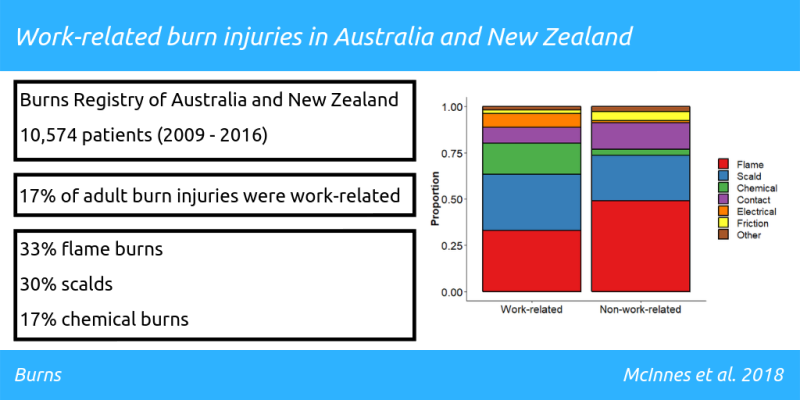Epidemiology of work-related burn injuries presenting to burn centres in Australia and New Zealand
Abstract
BACKGROUND: Burn injuries to workers can have a devastating impact, however knowledge of the epidemiology of work-related burn injuries in Australia and New Zealand is limited.
PURPOSE: To describe epidemiological characteristics of work-related burn injuries in Australia and New Zealand, and to compare these with non-work-related burns.
METHODS: Adult burn injury data, 2009-2016, were extracted from the Burns Registry of Australia and New Zealand. Descriptive statistics were used to describe demographic, injury, management and outcome characteristics. Differences between work-related and non-work-related injuries were assessed using Chi-square and Wilcoxon rank-sum tests.
RESULTS: Of 10,574 adult patients treated in burn centres in Australia and New Zealand, 2009-2016, 17% had work-related burns. Most work-related cases were male (85%), less than 35 years old (53%), and had sustained flame (33%), scald (30%) or chemicals (17%) burns. Proportions of chemical, scald and electrical burns were greater for work-related than for non-work-related burns, with this being most marked for chemical and electrical burns (17% vs. 3% and 7% vs. 1%, respectively).
CONCLUSIONS: Almost one in five cases of working-aged people admitted to Australian and New Zealand burns centres was work-related. Through identification of vulnerable groups, this study informs policy and strategies to minimise occupational burn risk.

Full citation
McInnes, J.A., Cleland, H.A., Tracy, L.M., Darton, A., Wood, F.W., Perrett, T., & Gabbe, B.J. (2019). Epidemiology of work-related burn injuries presenting to burn centres in Australia and New Zealand. Burns, 45(2): 484-493.
DOI: 10.1016/j.burns.2018.09.011